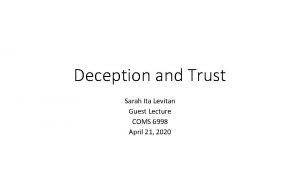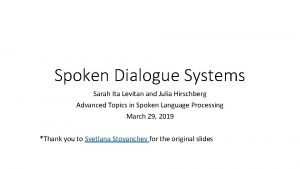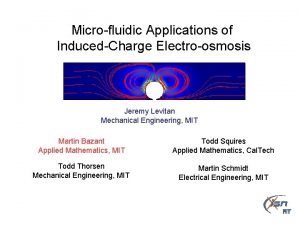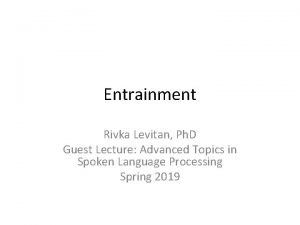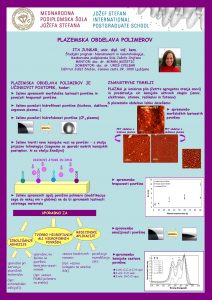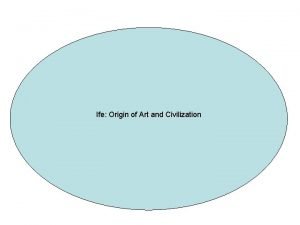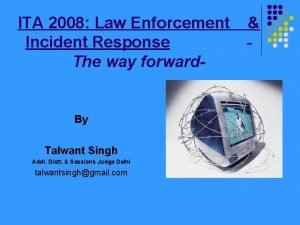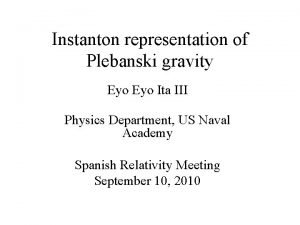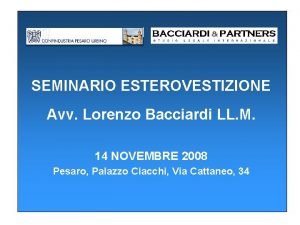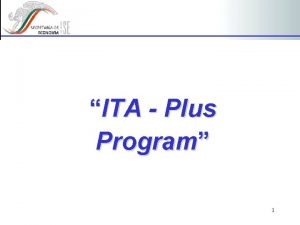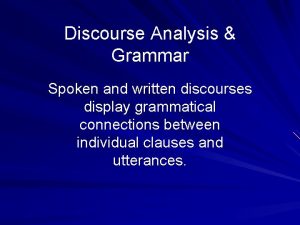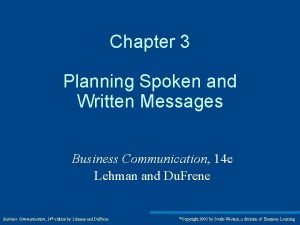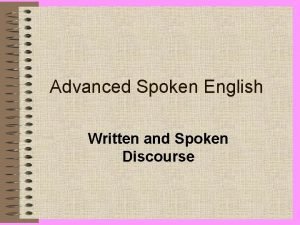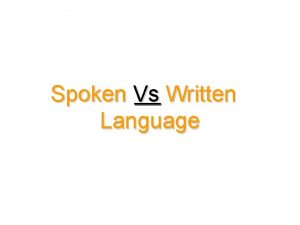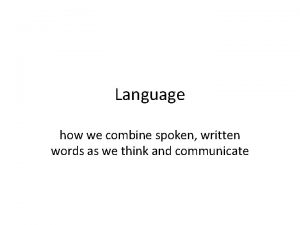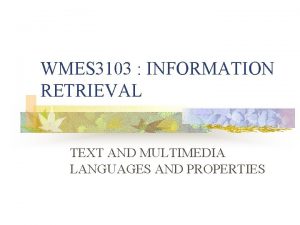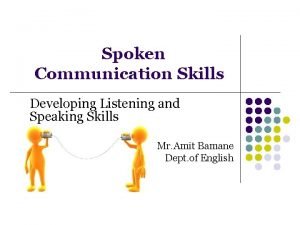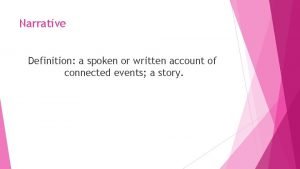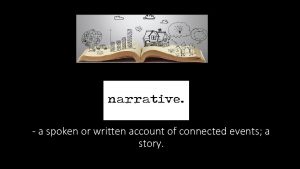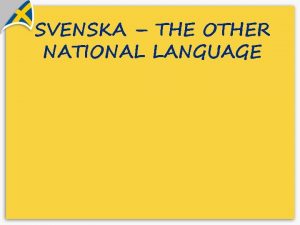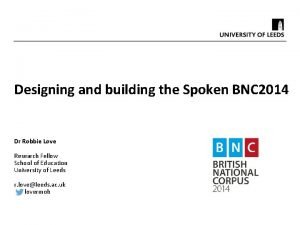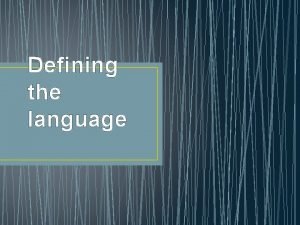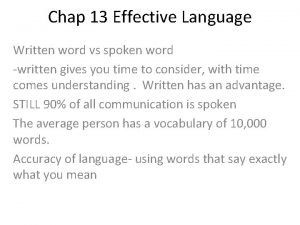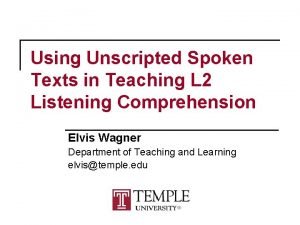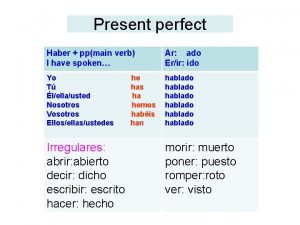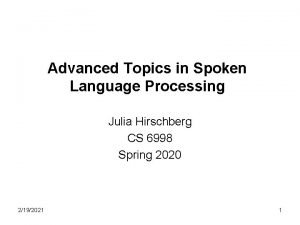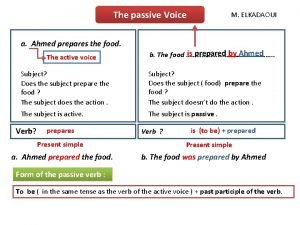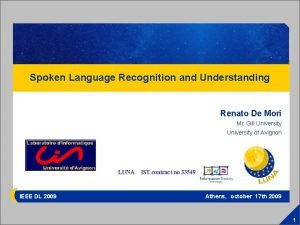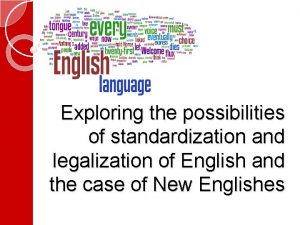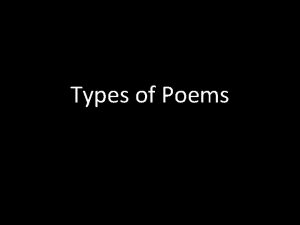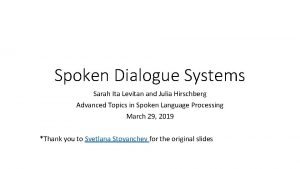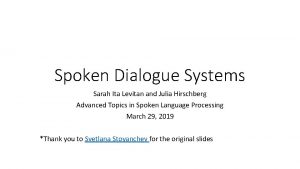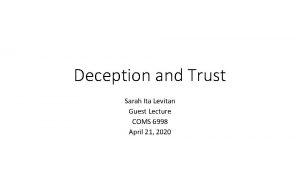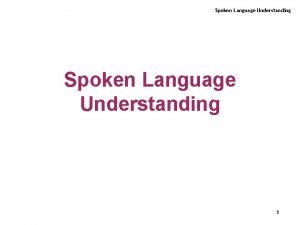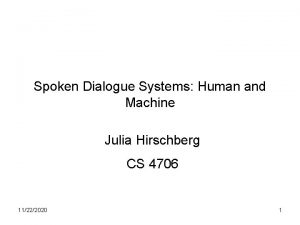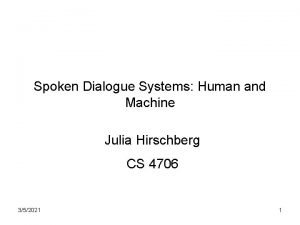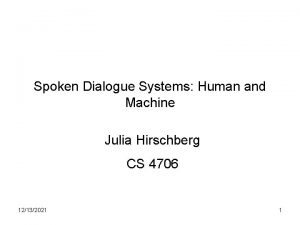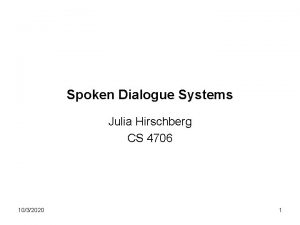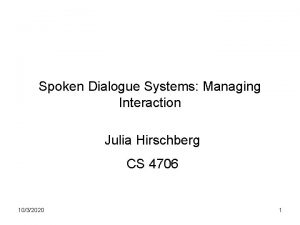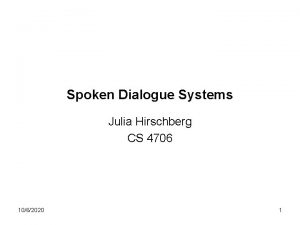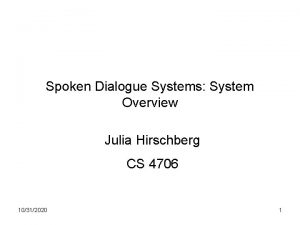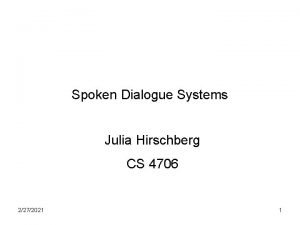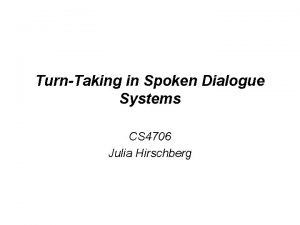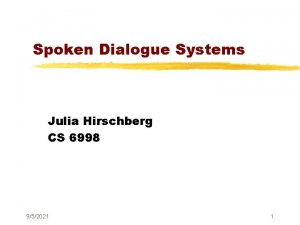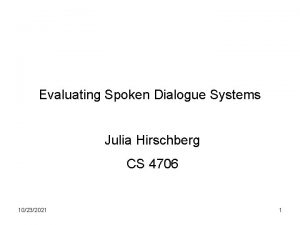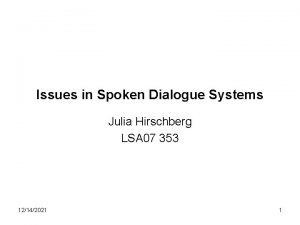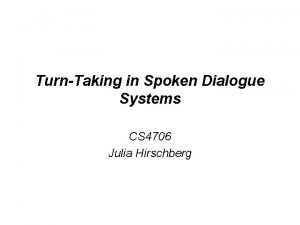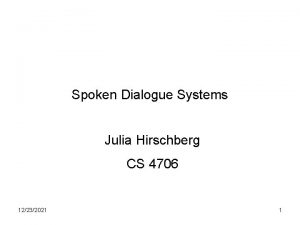Spoken Dialogue Systems Sarah Ita Levitan and Julia







































































- Slides: 71

Spoken Dialogue Systems Sarah Ita Levitan and Julia Hirschberg Advanced Topics in Spoken Language Processing March 29, 2019 *Thank you to Svetlana Stoyanchev for the original slides

What is Natural Language Dialogue? • Communication involving • Multiple contributions • Coherent interaction • More than one participant • Interaction modalities • Input: Speech, typing, writing, gesture • Output: Speech, text, graphical display, animated face/body (embodied virtual agent)

When is automatic dialogue system useful? • When hands‐free interaction is needed • • • In‐car interface In‐field assistant system Command‐control interface Language tutoring Immersive training • When speaking is easier than typing • Voice search interface • Virtual assistant (Siri, Google Now) • Replacing human agents (cutting cost for companies) • Call routing • Menu‐based customer help • Voice interface for customer assistance

Visions of dialogue from science fiction • Hal “ 2001: A Space Odyssey” (1968) • Naturally conversing computer • Star Trek (original 1966) • Natural language command control • Her (2013) • A virtual partner with natural dialogue capabilities

Examples of modern Virtual Assistant dialogue systems • Apple Siri (2010) • Supports questions in a set of domains • Answers open‐end questions • Cute “Easter egg” responses

Examples of modern Virtual Assistant dialogue systems • Android Google Now (2013) • Predictive search assistant • Windows Cortana (2014) • Works across different Windows devices • Aims to be able to “talk about anything”

Embedded devices with dialogue capabilities • Amazon Echo (2014) – home assistant device • Plays music • With voice commands • Question answering • Get weather, news • More complex questions, like • “how many spoons are in a cup? ” • Setting timer • Manages TODO lists

Embedded devices with dialogue capabilities Answers questions Sets time Device control and queries: Thermostat Etc. Uses Wolfram Alfa engine on the back‐end to answer questions

Embedded devices with dialogue capabilities Control ice machine Manage shopping list Stream music and TV Alexa compatible

When do you use dialogue systems?

Research Dialogue Systems • Research systems explore novel research questions in speech recognition/language understanding/generation/dialogue management • Research systems • Based on more novel theoretical frameworks • Open‐domain speech recognition • Focus on theory development • Transition from research to commercial • Siri came out of a DARPA‐funded research project

Tutoring (Litman & Silliman, 2004), U. Pittsburgh

CMU Bus Information • Bohus et al. (deployed in 2005) CMU • Telephone‐based bus information system • Deployed by Pittsburgh Port Authority • Receives calls from real users • Noisy conditions • Speech recognition word error rate ~ 50% • Use collected data for research • Provide a platform to allow other researchers to test SDS components

CMU Lets. Go Dialogue Example

Commercial vs. Research dialogue systems System Flexibility Research Goal Ability to accept varied input Support multiple wide range of queries Multiple domains User initiative Commercial System Reliability

Chatbots vs. Task-oriented dialogue systems Chatbots ‐ Designed for extended conversations ‐ Mimic unstructured human‐human interaction Task‐oriented dialogue systems ‐ Designed for a particular task ‐ Short conversations to get information from a user to help complete the task

Rule-based chatbots: ELIZA

Rule-based chatbots: ELIZA • Eliza (text only) (Joseph Weizenbaum, MIT, 1966) • A “psychologist” system • Example conversation: http: //www. masswerk. at/elizabot/ • • • ELIZA: Is something troubling you ? YOU: I am worried about teaching ELIZA: How long have you been worried about teaching ? YOU: For couple weeks ELIZA: Do you feel strongly about discussing such things ? YOU: yes ELIZA: You seem to be quite positive. YOU: I am concerned about choosing course content ELIZA: Do you believe it is normal to be concerned about choosing course content ?

Corpus-based chatbots • Information retrieval • Machine learning Corpora: • Twitter • Movies • Chat platforms

IR-based • Simple methods: 1. Return the response to the most similar turn 2. Return the most similar turn

ML-based • Sequence to sequence models (encoder‐decoder)

How do we evaluate chatbots? • Human evaluation • Adversarial evaluation

What is involved in NL dialogue • Understanding • What does a person say? • Identify words from speech signal • “Please close the window” • What does the speech mean? • Identify semantic content • Request ( subject: close ( object: window)) • What were the speaker’s intentions? • Speaker requests an action in a physical world

What is involved in NL dialogue • Managing interaction • Internal representation of the domain • Identify new information • Identifying which action to perform given new information • “close the window”, “set a thermostat” ‐> physical action • “what is the weather like outside? ” ‐> call the weather API • Determining a response • “OK”, “I can’t do it” • Provide an answer • Ask a clarification question

What is involved in NL dialogue • Access to information • To process a request “Please close the window” you (or the system) needs to know: • There is a window • Window is currently opened • Window can/can not be closed

What is involved in NL dialogue • Producing language • Deciding when to speak • Deciding what to say • Choosing the appropriate meaning • Deciding how to present information • So partner understands it • So expression seems natural

Types of dialogue systems • Command control • Actions in the world • Robot – situated interaction • Information access • Database access • Bus/train/airline information • Librarian • Voice manipulation of a personal calendar • API access • IVRs – customer service • Simple call routing • Menu‐based interaction • Allows flexible response “How may I help you? ” • Smart virtual assistant • Helps you perform tasks, such as buying movie tickets, trouble shooting • Reminds you about important events without explicit reminder settings

Aspects of Dialogue Systems • Which modalities does the system use • Voice only (telephone/microphone & speaker) • Voice and graphics (smartphones) • Virtual human • Can show emotions • Physical device • Can perform actions • Back‐end • which resources (database/API/ontology) it accesses • How much world knowledge does the system have • Hand‐built ontologies • Automatically learned from the web • How much personal knowledge does it have and use • Your calendar (google) • Where you live/work (google) • Who are your friends/relatives (facebook)

Dialog system components Voice input Speech Language Model/Grammar Acoustic model Hypothesis (automatic transcription) Text Generation templates/ rules Grammar/Models Logical form of user’s input 29 Logical form of system’s output

Dialog system components Voice input Speech Language Model/Grammar Acoustic model Hypothesis (automatic transcription) Text Generation templates/ rules Grammar/Models Logical form of user’s input 30 Logical form of system’s output

Speech recognition • Convert speech signal into text • Most SDS use off‐the‐shelf speech recognizers • Research systems are highly configurable: • Kaldi – most used research recognizer • Sphinx/pocket sphinx (java API) • Industry (free cloud version), not configurable • Google • Nuance • AT&T Watson

Speech recognition • Statistical process • Use acoustic models that maps signal to phonemes • Use language models (LM)/grammars that describe the expected language • Open‐domain speech recognition use LM built on large corpora

Speech recognition • Challenges: recognition errors due to • Noisy environment • Speaker accent • Speaker interruption, self correction, etc.

Speech recognition • Speaker‐dependent/independent • Domain dependent/independent

Speech recognition • Grammar‐based • Allows dialogue designer to write grammars • For example, if your system expects digits a rule: • S ‐> zero | one | two | three | … • Advantages: better performance on in‐domain speech • Disadvantages: does not recognize out‐of‐domain • Open Domain – large vocabulary • Use language models built on large diverse dataset • Advantages: can potentially recognize any word sequence • Disadvantages: lower performance on in‐domain utterances (digits may be misrecognized)

Dialog system components Voice input Speech Language Model/Grammar Acoustic model Hypothesis (automatic transcription) Text Generation templates/ rules Grammar/Models Logical form of user’s input 36 Logical form of system’s output

Natural Language Understanding • Convert input text into internal representation. Example internal representation in wit. ai: { "msg_body": "what is playing at Lincoln Center", "outcome": { "intent": "get_shows", "entities": { "Venue": { "value": "Lincoln Center", } }, "confidence": 0. 545 }, "msg_id": "c 942 ad 0 f‐ 0 b 63‐ 415 f‐b 1 ef‐ 84 fbfa 6268 f 2" }

NLU approaches • Can be based on simple phrase matching • “leaving from PLACE” • “arriving at TIME” • Can use deep or shallow syntactic parsing

NLU approaches • Can be rule‐based • Rules define how to extract semantics from a string/syntactic tree • Or Statistical • Train statistical models on annotated data • Classify intent • Tag named entities

Dialog system components Voice input Speech Language Model/Grammar Acoustic model Hypothesis (automatic transcription) Text Generation templates/ rules Grammar/Models Logical form of user’s input 40 Logical form of system’s output

Dialogue Manager (DM) • Is a “brain” of an SDS • Decides on the next system action/dialogue contribution • SDS module concerned with dialogue modeling • Dialogue modeling: formal characterization of dialogue, evolving context, and possible/likely continuations

DM approaches • Rule‐based • Key phrase reactive • Finite state/Tree based • model the dialogue as a path through a tree or finite state graph structure • Information‐state Update • Statistical (learn state transition rules from data or on‐line) • Hybrid (a combination of rules and statistical method)

Dialog system components Voice input Speech Language Model/Grammar Acoustic model Hypothesis (automatic transcription) Text Generation templates/ rules Grammar/Models Logical form of user’s input 43 Logical form of system’s output

NLG approaches • Presenting semantic content to the user • Template‐based • • • In a airline reservation system: User: “Find me a ticket from New York to London” System: “What date do you want to travel? ” User: “March 10” System: “There is a United flight from Newark airport to London Heathrow on March 10 leaving at 9: 15 AM” • Template: There is a AIRLINE flight from AIRPORT to AIRPORT on DATE leaving at TIME

Natural language generation (NLG) • Content selection • User asks “Find me restaurants in Chelsea” • System finds 100 restaurants • NLG decides how to present a response and which information to present • “I found 100 restaurants, the restaurant with highest rating is …” • “I found 100 restaurants, the closest to you is …” • “I found 100 restaurants, I think you would like …”

Dialog system components Voice input Speech Language Model/Grammar Acoustic model Hypothesis (automatic transcription) Text Generation templates/ rules Grammar/Models Logical form of user’s input 46 Logical form of system’s output

Frame-based dialogue system • Architecture introduced in GUS travel planning system (Bobrow et al. , 1977) • This architecture is used in most modern commercial digital assistants • Based on a domain ontology, which defines frames (collections of slots) and values that each slot can take


• Slots define what the system needs to know • Slot values are constrained to types

Control structure for frame-based dialogue

GUS architecture • Mixed initiative • Can fill slots in any order • Condition‐action rules attached to slots • Production rule system

NLU for filling slots • Domain classification • Intent determination • Slot filling “Show me morning flights from Boston to San Francisco on Tuesday” DOMAIN: AIR-TRAVEL INTENT: SHOW-FLIGHTS ORIGIN-CITY: Boston ORIGIN-DATE: Tuesday ORIGIN-TIME: morning DEST-CITY: San Francisco

Dialogue-state architecture • Capable of understanding and generating dialogue acts • Dialogue acts: utterance in the context of a dialogue that serves a function in the dialogue • e. g. question, statement, request for action, acknowledgment • Dialogue policy – decide what to say • Dialogue state tracker – maintain the current state of the dialogue


Dialogue acts • 4 major classes: 1. Constantives 2. Directives 3. Commissives 4. Acknowledgments

Common ground • Dialogue is a collective act performed by speaker and hearer; they must constantly establish common ground – the set of things that are mutually believed by both speakers • Principle of closure – agents performing an action require evidence that they have succeeded in performing it

Grounding methods • Continued attention • Next contribution • Acknowledgment • Demonstration • Display



Natural language generation (NLG) • 2 stages: 1. Content planning – what to say 2. Sentence realization – how to say it

SDS Evaluation • Task success • E. g. did the system book the correct flight? • Performance of SDS components • ASR (WER) • NLU (slot error rate) • DM/NLG (appropriate response)

SDS Evaluation • User satisfaction rating

Performance evaluation heuristics • Efficiency • System turns • User turns • Dialogue quality • Timeouts (when a user did not respond) • Rejects (when the system confidence is low leading to “I am sorry I did not understand”) • Help – number of times the system believes that a user said ‘help’ • Cancel ‐ number of times the system believes that a user said ‘cancel’ • Barge‐in

Dialogue System Design User‐centered design: (Gould & Lewis, 1985) 1. Study the user and task 2. Build simulations and prototypes Wizard‐of‐Oz system 3. Iteratively test the design on users

Ethical Issues • Bias Microsoft Tay chatbot • Privacy • Stereotypes • Impersonating humans Google duplex

Tools for building SDS • Open. Dial – DM framework; Pierre Lison (2014) • Wit. ai – A tool for building ASR/NLU for a system

Open. Dial • Pierre Lison’s Ph. D thesis 2014 • DM components can run either synchronously or asynchronously • ASR/TTS: Open. Dial comes with support for commercial off‐the shelve ASR (Nuance & AT&T Watson) • NLU: based on probabilistic rules • XML NLU rules • DM: rule‐based. Dialogue states triggered with rules • XML DM rules • NLG: template‐based • XML NLG rules

Wit. AI • 2013 start up bought by Facebook • Web‐based GUI to build a hand‐annotated training corpus of utterances • Developer types utterances corresponding to expected user requests • Builds a model to tag utterances with intents • Developer can use API using python, javascript, ruby, and more • Given speech input, output intent and entity tags in the output

Specialty Topics for Dialogue Systems • • • • turn‐taking mixed‐initiative referring in dialogue grounding and repair dialogue act modeling dialogue act recognition error recovery in dialogue prosody and information structure Argumentation & persuasion incremental speech processing multi‐modal dialogue multi‐party dialogue (3 or more participants) tutorial dialogue multi‐task dialogue • embodied conversational agents • human‐‐‐robot dialogue interaction • dialogue tracking in other language‐ ‐‐processing systems (machine translation, summarization/extrac. on) • non‐‐‐cooperative dialogue systems (negotiation, deception) • affective dialogue systems • dialogue with different user populations (children, elderly, differently abled) • dialogue “in the wild” • long‐term Dialogue Companions • user behavior, including entrainment in dialogue

Specialty Topics for Dialogue Systems • • • • turn‐taking mixed‐initiative referring in dialogue grounding and repair dialogue act modeling dialogue act recognition error recovery in dialogue prosody and information structure Argumentation & persuasion incremental speech processing multi‐modal dialogue multi‐party dialogue (3 or more participants) tutorial dialogue multi‐task dialogue • embodied conversational agents • human‐‐‐robot dialogue interaction • dialogue tracking in other language‐ ‐‐processing systems (machine translation, summarization/extrac. on) • non‐‐‐cooperative dialogue systems (negotiation, deception) • affective dialogue systems • dialogue with different user populations (children, elderly, differently abled) • dialogue “in the wild” • long‐term Dialogue Companions • user behavior, including entrainment in dialogue

Homework #3 • Dialogue Act Recognition (DAR)
 Sarah ita levitan
Sarah ita levitan Sarah ita levitan
Sarah ita levitan Jeremy levitan
Jeremy levitan Lois levitan
Lois levitan Rivka levitan
Rivka levitan Júlia jellemzése
Júlia jellemzése What is congratulation expression
What is congratulation expression Counterbalance forklift ita classification
Counterbalance forklift ita classification Ita junkar
Ita junkar King from ita yemoo
King from ita yemoo King from ita yemoo
King from ita yemoo Ita 2008
Ita 2008 Eyo ita physics
Eyo ita physics Sepuluh tahun yang lalu umur ita dua kali umur tika
Sepuluh tahun yang lalu umur ita dua kali umur tika Ita
Ita Ita skin
Ita skin Itaplus
Itaplus Ita
Ita Ita
Ita Sottotitoli ita
Sottotitoli ita Ita corpbanca
Ita corpbanca No vácuo uma moeda e uma pena caem igualmente
No vácuo uma moeda e uma pena caem igualmente Dd ita
Dd ita Pelipsu
Pelipsu Spoken english and broken english g.b. shaw summary
Spoken english and broken english g.b. shaw summary Prose in romeo and juliet
Prose in romeo and juliet Akkudativ
Akkudativ Display
Display This can be spoken and written messages
This can be spoken and written messages Types of discourse
Types of discourse Spoken vs written
Spoken vs written Spoken english and broken english summary
Spoken english and broken english summary Ciarajuliet
Ciarajuliet In a language the smallest distinctive sound unit
In a language the smallest distinctive sound unit Decision support systems and intelligent systems
Decision support systems and intelligent systems Multimedia information retrieval in irs
Multimedia information retrieval in irs What language is spoken in vietnam
What language is spoken in vietnam Back chanelling
Back chanelling Spoken word poetry allows you to be anyone you want to be
Spoken word poetry allows you to be anyone you want to be Marginal listener
Marginal listener Love poem in swahili
Love poem in swahili Spoken or written account of connected events
Spoken or written account of connected events Where was latin spoken
Where was latin spoken Turn constructional component
Turn constructional component Spoken or written description of an event
Spoken or written description of an event Ten day spoken sanskrit classes
Ten day spoken sanskrit classes What language is svenska
What language is svenska Spoken poetry about cultural relativism
Spoken poetry about cultural relativism Naxos spoken word library
Naxos spoken word library Most spoken language in the world
Most spoken language in the world Bnc 2014
Bnc 2014 It is a system of conventional spoken manual
It is a system of conventional spoken manual Written word vs spoken word
Written word vs spoken word Most spoken language in the world
Most spoken language in the world Spoken texts examples
Spoken texts examples Present perfect spoken
Present perfect spoken Spoken peer pressure
Spoken peer pressure Monegasque
Monegasque Adv spoken language processing
Adv spoken language processing Peer pressure meaning
Peer pressure meaning Voice chart with example
Voice chart with example Renato de mori
Renato de mori Languages spoken in india
Languages spoken in india What is a direct character
What is a direct character Example of epic poetry
Example of epic poetry Touchscreen slam poem
Touchscreen slam poem Oral english text
Oral english text Dangling preposition
Dangling preposition Poem on gender inequality
Poem on gender inequality Words spoken by the characters onstage
Words spoken by the characters onstage African xxxx
African xxxx The flemings and walloons live in
The flemings and walloons live in
